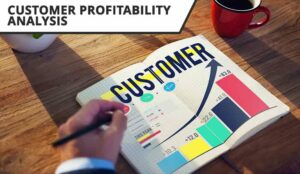Have you been asked to run a customer profitability analysis exercise, but don’t know where to start? Don’t panic!
In this article, Martin Jukes at Mpathy Plus shares his experience of conducting a customer profitability analysis and what you need to know to get started.
What Is Customer Profitability Analysis?

Jukes
The question of how to calculate customer profitability is complex and varied depending on the type of business.
But in very simple terms, the calculation should be based on how much profit is made from a customer after all of their costs are considered.
Costs include the total servicing costs for each customer. This may include the number of times they contact your organization.
The key point is about how we understand what a customer lifecycle is and then how we calculate overall spend and resultant profitability.
It’s well worth noting that the term of a customer lifecycle has also reduced. We are encouraged to change suppliers based on a few factors, but most commonly price. The level of churn is high as price sensitivity and economic pressures continue to influence behaviour.
Start by Getting Executive-Level Sponsorship
If we are going to utilize what would appear to be a common-sense business-driven approach and provide a segmented service based on profitability, then we need to have executive-level sponsorship and to be very clear about the future vision.
A starting point must be the sponsorship.
A business paper would be a good starting point, with the opportunity to discuss and explain the following:
- Why should we consider customer profitability analysis?
- How might it change customers’ behaviours?
- How do we measure it? What analytical tools are available?
- What are the key measures required? What is the length of time being considered for profitability?
- How are we going to capture the information about customer behaviour and profitability?
- How do we engage frontline staff to be involved/provide feedback?
Calculate the Cost per Contact and Then Produce Some Scenarios
Starting points could involve calculating the cost per contact and then producing some scenarios.
Typical scenarios could be:
- Customer A contacts us once a month by telephone to complain about interest rates. They have an average balance in their account of £100.
- Customer B never contacts us and is a frequent purchaser of our products through subscription services.
- Customer C makes frequent contact but is one of our highest-spending customers.
- Customer D has been a customer for 10 years and has a mortgage, savings accounts and various insurance policies with us.
The difference is very visible and, once data is applied, it will be clear as to where the profitability lies and where there are opportunities to respond and treat customers appropriately.
Involve Frontline Agents in the Process
A top tip is to involve frontline agents in the process. They interact with customers all of the time and have a good awareness of what influences customer behaviour in their organization.
Through their experience they have the brand awareness to be able to add real value to both the design and implementation of the process.
For top tips and strategies on how best to gather customer feedback from your frontline agents, read our article: Want Your Frontline Staff to Share More Customer Feedback? Try This!
Don’t Discount the Influence or Reputation of Certain Customers
One final consideration. Some customers are representing others and therefore make more contacts. Often classed as VIPs, they may be local councillors, board members, user group representatives, etc.
They are providing a different value to the organization, so it is not just about financial profitability, it could also be about influence, reputation or the added value that these people provide.
It Is Readily Accepted That Services and Products Need to Be Profitable
Some years ago, there was an outcry when banks started to close some customers’ accounts. The reason they gave was that these accounts were unprofitable, so the banks were effectively losing money by keeping them open.
Customers did not like it, but it highlighted that banks and other financial institutions were changing and become more commercially focused. It also highlighted a reduction in the timescales over which organizations are making decisions.
It is readily accepted that services and products need to be profitable. If a new product has lots of issues, then there could be a significant cost (both financial and reputational) in resolving those issues.
It is likely that a product with these issues would be withdrawn from sale or replaced. If a coach company were to provide services that were hardly used, then having half-empty coaches would also be seen to be unprofitable, and we would not expect it to keep running that service in isolation.
It is also worth exploring the relationship between customer experience (CX) and profitability. For more information, read our article: Is There a Link Between Customer Experience and Profitability?
But We Do Expect Some Services Will Continue – Even If They Make a Loss
But we do have an expectation that some services will continue to be provided even if they make a loss, so why should it be different with customers?
We have a postal service that is under scrutiny for poor performance as it struggles to meet its obligations and remain profitable. Some postal services will be more profitable than others, but we expect them to be the same everywhere.
Public transport is not profitable on every route, but we expect those more profitable routes to subsidize those that are making a loss; we accept that.
We do have an expectation that some services will continue to be provided even if they make a loss, so why should it be different with customers?
In today’s world we accept that services may be differentiated depending on the level of spend. Simplistically, we know that by spending more money on a theatre ticket we will have a better view of the performance.
Another example would be the potential for upgrades or free travel for frequent flyers with the use of air miles or similar schemes.
Some Organizations Provide a Differentiated Service Based Upon Profitability
But it is not only about segmenting by spend amounts. What I also find is that there are some organizations that provide a differentiated service based upon factors that may impact profitability.
I have worked with social housing providers that ‘score’ customers and then deliver a different level of service depending on the customer’s score.
For example, if a customer is frequently in arrears and responsible for anti-social behaviour, they may not have their repairs completed as quickly as customers who pay their rent regularly. Some will disagree with this approach, but it is very much down to the organization’s policy.
After all, there is a cost to managing arrears/debt collection and managing anti-social behaviour, and therefore those customers are less profitable, or in this case probably costing the organization money to house them.
Written by: Martin Jukes, Managing Director at Mpathy Plus
If you are looking for advice on getting more budget or calculating customer value, read these articles next:
- How to Calculate Customer Lifetime Value – The Formula
- Proven Ways to Get More Budget for Your Contact Centre
- How to Calculate Customer Profitability
Author: Martin Jukes
Reviewed by: Megan Jones
Published On: 16th Jul 2024 - Last modified: 17th Jul 2024
Read more about - Customer Service Strategy, Customer Management, Customer Service, Martin Jukes, Top Story, Top Technology Stories









































